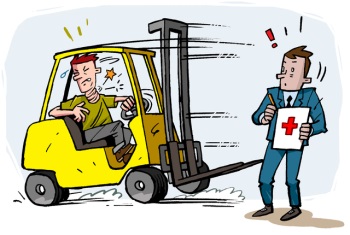Complete Powerpoint slide presentation for forklift instructors. Ready made training course
rsi and forklift trucks
 This article by Mitsubishi Forklift Trucks explains the dangers of repetitive Strain Injury associated with the use of forklift trucks.
This article by Mitsubishi Forklift Trucks explains the dangers of repetitive Strain Injury associated with the use of forklift trucks.
Fatal and life-changing forklift accidents may grab the headlines but longer term injuries affect countless workers every day.
Repetitive strain injuries are most often associated with workers using computers or pneumatic drills but upper limb disorders affecting forklift operators are costing businesses many thousands of Euros hours every year.
It’s probably not the first thing you consider when selecting a new forklift but with RSI related injuries so common in the workplace, the ergonomics of the forklift cabin could and should, deserve a closer look.
Don’t think it’s an issue that could affect your business? Well, a survey by pain relief brand Mentholatum found that one in five adults (21 per cent) have suffered from RSI. And that includes forklift drivers. So, what’s causing all the problems, and what can you do to avoid them?
What are RSIs?
Repetitive strain injuries (RSI) come under a variety of other names: you might see them listed as Work-Related Upper Limb Disorders (WRULDs), Cumulative Trauma Disorders (CTDs), Occupational Overuse Syndrome (OOS), or Troubles Musculo-Squelettiques (TMS). Whatever the name, they refer to conditions which affect the muscles, tendons, ligaments, joints or nerves in the upper limbs, anywhere between the neck and the fingers.
What causes RSIs?
RSIs can develop through a wide range of working practices across a wide range of industries. Working for long periods in an uncomfortable or unnatural posture is a major cause, particularly if the individual concerned doesn’t have suitable rest breaks.
We’ve all heard of the lasting damage that can be caused by repeatedly moving a mouse at a desk, (Webmaster: I know the feeling), well imagine what the arm of a forklift operator undergoes throughout a typical shift.
If, as a result of all that activity, an operator starts complaining of stiffness, cramp, numbness, tingling, tenderness, or swelling then there’s a good chance they could be developing an RSI.
If not tackled at an early stage these symptoms can develop into permanent injury. Leading up to that point they can cause a driver great pain and stress which, in turn, can lead to reduced concentration and the very real risk of a serious accident.
But how does it affect you?
If a proportion of your workforce suffer health problems because of their work, don’t be surprised if this has a significant impact in terms of sick pay, cost of temporary staff to replace them, compensation for work-related injuries plus the indirect effects upon staff morale, reduced productivity and an increase in accidents.
Studies have estimated the cost to businesses as a result of RSIs at around 0.5–2% of GNP. A study in the Netherlands put the costs for compensation, sick pay, and other payouts at €2.1b per year, with €808m in productivity lost through workers suffering from RSIs.
What can be done?
Prevention is, of course, better than cure. When it comes to RSIs, the most commonly seen injuries in fork lift truck operators are back pain from pulling heavy loads on hand pallet trucks, knee and ankle strains from hopping on and off lift trucks and neck strain due to looking over the shoulder while reversing. So, we’d recommend looking closely at safeguards that manufacturers have incorporated into their lift trucks.
While different design approaches are taken, there are a growing number of modern trucks that are becoming better equipped to minimise the risks leading to RSIs. Seating with proper support, for example, can help encourage correct posture while driving and ease strain that might otherwise become detrimental during long shifts.
Support your drivers
Mitsubishi take an ergocentric approach to design, with trucks designed around the driver. Mitsubishi’s SENSiA EM, SENSiA EX, and EDiA EM, for example, all have our latest ergonomic armrest. Uniquely, it fully supports the whole wrist, forearm, and shoulder for maximum comfort while greatly reducing strain and stress.
What’s more, it’s fully adjustable, meaning you can properly support each of your drivers in their natural operating position, while offering easy fingertip access to many key controls.
And features like FeatherTouch steering can help too, just six turns lock-to-lock and low-effort to turn means less stress on the arm and fewer movements needed per shift.
These are symptomatic of the philosophy adopted by the Mitsubishi design team in creating trucks that make a genuine difference to operator performance and welfare over the long term.
Reduce risk
Carry out a risk assessment to establish how and where your employees might be most affected. Make sure they have sufficient breaks during their shifts. Proper operator training and supervision is an important part. It’s one thing to provide an ergonomically designed truck, but another making sure they are fully-versed in how to operate it properly.
Our conclusion?
With a problem as widespread as RSI, it’s wise to put operator comfort, support and ergonomics high up on your shopping list. The right trucks and the right working practices can go a long way in preventing problems.
Disclaimer. The legislative information contained on this web site is my interpretation of the law based on many years in the health and safety business. A definitive interpretation can only be given by the courts. I will therefore not be held responsible for any accident/incident/prosecution arising as a consequence of anyone using any information obtained from this web site.